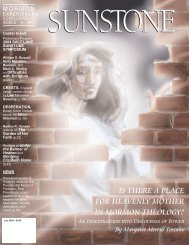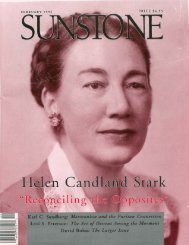Download Entire Issue PDF - Sunstone Magazine
Download Entire Issue PDF - Sunstone Magazine
Download Entire Issue PDF - Sunstone Magazine
You also want an ePaper? Increase the reach of your titles
YUMPU automatically turns print PDFs into web optimized ePapers that Google loves.
S U N S T O N E<br />
82 (near end of long, first paragraph), original in Western Americana, Beinecke<br />
Rare Book and Manuscript Library, Yale University, New Haven, Connecticut.<br />
Recent transcriptions of the original sometimes inaccurately lowercase<br />
“Prophet,” as in Milton V. Backman Jr., “Truman Coe’s 1836 Description of<br />
Mormonism,” BYU Studies 17 (Spring 1977): 352.<br />
24. In fact, that is what Jeff Lindsay did in his Internet article, “Militias and<br />
Mormon Culture??”<br />
25. Although there is a regional emphasis on the South in much of the literature<br />
about the code of male honor in early America, it was a national phenomenon,<br />
as indicated in the previously cited studies by Brown (R.M.),<br />
Courtwright, Hartog, Ireland, Kaplan, Lombard, Martin, Moore, Stevens, and<br />
Van Trump/Cannon. For cross-cultural studies of the usually violent dimensions<br />
of male honor, see Donna T. Andrew, “The Code of Honour and Its<br />
Critics: The Opposition to Duelling in England, 1700–1850,” Social History 5<br />
(October 1980): 409–34; Robert A. Nye, Masculinity and Male Codes of Honor in<br />
Modern France (New York: Oxford University Press, 1993); Kevin McAleer,<br />
Dueling: The Cult of Honor in Fin-de-Siecle Germany (Princeton, NJ: Princeton<br />
University Press, 1994); Robert A. Nye, “The Modern Duel and Masculinity in<br />
Comparative Perspective,” Masculinities 3 (Fall 1995): 69–79; Elizabeth<br />
Foyster, “Male Honour, Social Control and Wife Beating in Late Stuart<br />
England,” Transactions of the Royal Historical Society 6 (1996): 215–24; Petrus<br />
Cornelius Spierenburg, ed., Men and Violence: Gender, Honor, and Rituals in<br />
Modern Europe and America (Columbus: Ohio State University Press, 1998);<br />
Elizabeth Foyster, “Boys Will Be Boys?: Manhood and Aggression, 1600–1800,”<br />
in Tim Hitchcock and Michele Cohen, eds., English Masculinities, 1660–1800<br />
(London: Longman, 1999), 151–66; Thomas W. Gallant, “Honor, Masculinity,<br />
and Ritual Knife Fighting in Nineteenth-Century Greece,” American Historical<br />
Review 105 (April 2000): 359–82.<br />
26. Joseph Smith diary, 21 February 1843, in Joseph Smith Jr., et al., History<br />
of the Church of Jesus Christ of Latter-day Saints, 7 vols. (Salt Lake City: Church<br />
of Jesus Christ of Latter-day Saints, 1902–32; 2nd ed. rev. [Salt Lake City:<br />
Deseret Book Co., 1978], hereafter History of the Church), 5: 285 (“till he said<br />
he had enough”); Scott H. Faulring, ed., An American Prophet’s Record: The<br />
Diaries and Journals of Joseph Smith (Salt Lake City: Signature Books/Smith<br />
Research Associates, 1987), 310 (“till he said enough”). This would have appeared<br />
in the never-published third volume of Dean C. Jessee, ed., The Papers of<br />
Joseph Smith, 2 vols., with a different subtitle for each volume (Salt Lake City:<br />
Deseret Book Co., 1989–92).<br />
27. Joseph Smith diary, 1 January 1843, in Faulring, An American Prophet’s<br />
Record, 267.<br />
28. History of the Church, 5: 216; also Rodger I. Anderson, Joseph Smith’s<br />
New York Reputation Reexamined (Salt Lake City: Signature Books, 1990).<br />
29. History of the Church, 1: 261–65; Max H. Parkin, “A Study of the Nature<br />
and Cause of Internal and External Conflict of the Mormons In Ohio Between<br />
1830 and 1838,” M.A. thesis, Brigham Young University, 1966, 248–55; Donna<br />
Hill, Joseph Smith: The First Mormon (Garden City, NY: Doubleday, 1977),<br />
144–47; Susan Easton Black, “Hiram, Ohio: Tribulation,” in Larry C. Porter and<br />
Black, eds., The Prophet Joseph: Essays On the Life and Mission of Joseph Smith<br />
(Salt Lake City: Deseret Book Co., 1988), 161–74; Karl Ricks Anderson,<br />
“Hiram, Ohio,” in Daniel H. Ludlow, ed., Encyclopedia of Mormonism: The<br />
History, Scripture, Doctrine, and Procedure of the Church of Jesus Christ of Latterday<br />
Saints, 5 vols. (New York: Macmillan, 1992), 2: 588; Blaine Yorgason and<br />
Brent Yorgason, Joseph Smith: Tarred and Feathered (Orem, UT: Grandin Books,<br />
1994). History of the Church, 1: 261n, explained that Rider apostatized because<br />
a revelation misspelled his name, but this official LDS account ironically<br />
misspelled both the first and last names of “SYMONDS RIDER,” as he signed<br />
his name in bold-face in a letter to the editor condemning the Mormons, in<br />
Ohio Star (Ravenna, OH), 29 December 1831.<br />
30. D. Elton Trueblood, Studies in Quaker Pacifism (Philadelphia: Friends<br />
Peace Committee, 1934); Peter Brock, The Quaker Peace Testimony, 1660 to<br />
1914 (York, Eng.: Sessions Book Trust; Syracuse, NY: Syracuse University Press,<br />
1990).<br />
31. History of the Church, 1: 390–95; Richard L. Bushman, “Mormon<br />
Persecutions in Missouri, 1833,” BYU Studies 3 (Autumn 1960): 11–20; Warren<br />
A. Jennings, “Zion is Fled: The Expulsion of the Mormons from Jackson<br />
County, Missouri,” Ph.D. dissertation, University of Florida, 1962; Warren A.<br />
Jennings, “Factors in the Destruction of the Mormon Press in Missouri, 1833,”<br />
Utah Historical Quarterly 35 (Winter 1967): 57–76; Warren A. Jennings, “The<br />
Expulsion of the Mormons from Jackson County, Missouri,” Missouri Historical<br />
Review 64 (October 1969): 41–63; T. Edgar Lyon, “Independence, Missouri,<br />
and the Mormons, 1827–1833,” BYU Studies 13 (Autumn 1972): 10–19;<br />
Warren A. Jennings, “The City in the Garden: Social Conflict in Jackson<br />
County, Missouri,” in F. McKiernan, Blair, and Edwards, Restoration Movement,<br />
99–119; Ronald E. Romig and John H. Siebert, “Jackson County, 1831–1833: A<br />
Look at the Development of Zion,” Restoration Studies 3 (1986): 286–304;<br />
Church History in the Fulness of Times (Salt Lake City: Church Educational<br />
System, the Church of Jesus Christ of Latter-day Saints, 1989), 127–39; Ronald<br />
E. Romig and John H. Siebert, “First Impressions: The Independence, Missouri,<br />
Printing Operation, 1832–1833,” John Whitmer Historical Association Journal 10<br />
(1990): 51–66; James B. Allen and Glen M. Leonard, The Story of the Latter-day<br />
Saints, 2nd ed. rev. (Salt Lake City: Deseret Book Co., 1992), 94–95; Robert J.<br />
Woodford, “Book of Commandments,” Clark V. Johnson, “LDS Communities<br />
in Jackson and Clay Counties,” Max H. Parkin, “Missouri Conflict,” in Ludlow,<br />
Encyclopedia of Mormonism, 1: 138, 2: 922–25, 927–28.<br />
32. John Corrill, A Brief History of the Church of Christ of Latter Day Saints,<br />
(Commonly Called Mormons;) . . . With the Reasons for the Author for Leaving the<br />
Church (St. Louis: By the author, 1839), 19.<br />
33. The best work on this idea/theology during Joseph Smith’s lifetime is<br />
Grant Underwood, The Millenarian World of Early Mormonism (Urbana:<br />
University of Illinois Press, 1993). For the continued legacy of Smith’s statements,<br />
the disappointed expectations of his followers, and the institutional redefinitions<br />
by the LDS Church (headquartered in Salt Lake City), see Dan<br />
Erickson, As a Thief in the Night: The Mormon Quest For Millennial Deliverance<br />
(Salt Lake City: Signature Books, 1998).<br />
34. For the full text, context, and implications of this 1833 revelation, see<br />
my The Mormon Hierarchy: Origins of Power (Salt Lake City: Signature<br />
Books/Smith Research Associates, 1994), 80–84. Nevertheless, as I discuss on<br />
its page 111, early Mormon pamphleteering and editorials continued to describe<br />
theocracy as a distant, millennial circumstance until Smith changed the<br />
emphasis both publicly and privately in 1842.<br />
35. Note 31; History of the Church, 1: 407, 410–15, 423–31; Howard H.<br />
Barron, Orson Hyde: Missionary, Apostle, Colonizer (Bountiful, UT: Horizon<br />
Publishers, 1977), 42–43; also B. Pixley’s different perspective about this<br />
Mormon “ambuscade” in his letter to editors of New York Observer, 7<br />
November 1833, in William Mulder and A. Russell Mortensen, eds., Among the<br />
Mormons: Historic Accounts by Contemporary Observers (New York: Alfred A.<br />
Knopf, 1958), 81–83.<br />
William G. Hartley, My Best For the Kingdom: History and Autobiography of<br />
John Lowe Butler, A Mormon Frontiersman (Salt Lake City: Aspen Books, 1994),<br />
44–45, also interpreted the military provisions of the 1833 revelation in a cumulative<br />
manner. However, he offered a lengthier time frame: “ . . . Saints probably<br />
counted the expulsion from Jackson [in 1833] as one provocation and the<br />
forced departure from Clay County [in 1836] as a second. Persecutions in<br />
Kirtland and its collapse [in late 1837] might have been seen as a third offense.<br />
Expected abuses of Saints in northern Missouri [in mid-1838] could easily run<br />
the count up past four.” To the contrary, as indicated in my discussion to follow,<br />
an 1834 revelation and commandment verified that the three-fold restraints of<br />
the 1833 revelation had been fulfilled and no longer applied.<br />
36. B.F. Norris to Mark Norris, 6 January 1834, Mark Norris papers, Burton<br />
Historical Collection, Detroit Public Library, Detroit, Michigan.<br />
37. History of the Church, 1: 493, 263; Warren A. Jennings, “The Army of<br />
Israel Marches Into Missouri,” Missouri Historical Review 62 (January 1968):<br />
107–35; Roger D. Launius, Zion’s Camp: Expedition to Missouri (Independence,<br />
MO: Herald Publishing House, 1984); Lance D. Chase, “Zion’s Camp,” in<br />
Ludlow, Encyclopedia of Mormonism, 4: 1627–29; Bruce A. Van Orden, “Zion’s<br />
Camp: A Refiner’s Fire,” in Porter and Black, The Prophet Joseph, 192–207.<br />
38. History of the Church, 2: 39.<br />
39. History of the Church, 2: 88 (referring to 12 June 1834).<br />
40. History of the Church, 2: 39, 180–86, 201–04.<br />
41. Nicholas Lockyer, Christ’s Communion With His Church Militant . . .<br />
(London: John Rothwell, 1644); William Tilson Marsh, The Tabernacle and the<br />
Temple, or, The Church Militant, and the Church Triumphant . . . (London:<br />
Hatchard; Birmingham: J.M. Knott; Colchester, Eng.: Taylor, 1839); Hymns of<br />
the Church Militant (New York: R. Carter, 1858).<br />
42. Joseph Smith diary, 1 January 1843, in Faulring, An American Prophet’s<br />
Record, 267; History of the Church, 5: 216, deleted this entry; see Note 26, last<br />
sentence. Luke S. Johnson served as Kirtland’s constable from April 1834 to<br />
April 1835, and not again until the last week of December 1837. The latter period<br />
would have been too late for this incident due to Smith’s own hasty retreat<br />
from Ohio in January 1838. See Kirtland Township Trustees minutes<br />
(1817–38), 123–24 (7 April 1834), 135 (6 April 1835), 161 (23 December<br />
1837), Lake County Historical Society, Mentor, Ohio.<br />
OCTOBER 2011 PAGE 31

















